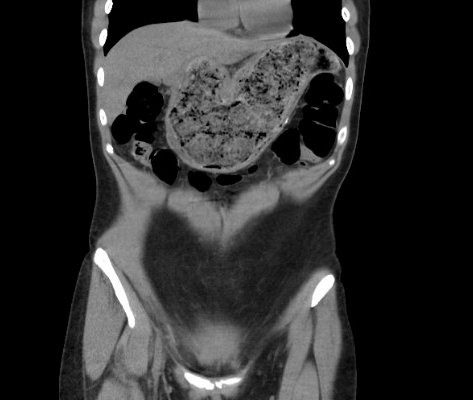Monday Poster Session
Category: Stomach and Spleen
P4256 - Rapunzel Syndrome Revisited: A Case of Recurrent Trichobezoar in a Young Adult
Monday, October 27, 2025
10:30 AM - 4:00 PM PDT
Location: Exhibit Hall
- AC
Apoorva Cherukuri, MD
West Anaheim Medical Center
Anaheim, CA
Presenting Author(s)
Apoorva Cherukuri, MD1, Chethan Raj Gundoji, MBBS1, Pavan Kumar Reddy Kalluru, MD2, Deekshitha Kuchi, MBBS1, Pradeep Pentapurthy, MD3, Andrew S. Iraniha, MD1
1West Anaheim Medical Center, Anaheim, CA; 2West Anaheim Medical Center, Anahem, CA; 3Wayne State University School of Medicine, Detroit, MI
Introduction: Trichobezoars are hair masses in the stomach, typically seen in patients with trichophagia and trichotillomania. When the mass extends into the small intestine, it is termed Rapunzel syndrome - a rare but serious condition mostly affecting adolescent females. Named after the long-haired fairy tale character, it often presents with vague GI symptoms like abdominal pain, nausea, vomiting, or obstruction, frequently leading to delayed diagnosis.
Case Description/
Methods: We report a case of a 20-year-old female with a history of pica and prior surgery in 2015 for trichobezoar removal, presenting with intermittent, hunger-like abdominal pain (6/10), nausea, and chills. She denied vomiting, fever, diarrhea, or hematochezia. Social history revealed daily cannabis use. Exam showed mild abdominal tenderness, and labs revealed iron deficiency anemia. A non-contrast CT abdomen demonstrated marked gastric distension, raising concern for gastric outlet obstruction. Suspecting recurrent trichobezoar, endoscopic removal was attempted but unsuccessful due to the size. She underwent laparoscopic surgery, converted to mini-laparotomy, with successful bezoar removal. Postoperatively, she was transitioned to a soft diet, received IV iron, and was discharged on oral iron and a proton pump inhibitor. Psychiatry and social work were involved, and she was provided with outpatient behavioral health support to address underlying pica and aerophagia.
Discussion: Trichobezoars related to trichotillomania should be considered in the differential diagnosis for young patients with psychiatric comorbidities who present with unexplained gastrointestinal symptoms. The risk of recurrence remains significant without comprehensive psychiatric intervention. In this case, persistent hair ingestion—despite prior surgical intervention—was associated with underlying anxiety, underscoring the chronic and relapsing nature of this behavioral disorder. Effective management requires a multidisciplinary approach, including surgical, psychiatric, and behavioral health support. Long-term psychiatric follow-up and behavioral therapy are essential in preventing recurrence. This case emphasizes the importance of early recognition and coordinated, multidisciplinary management. Clinicians should maintain a high index of suspicion for trichobezoars in patients with unexplained gastrointestinal symptoms and a history of pica, trichotillomania, or other psychiatric disorders.

Figure: CT Abdomen image showing distended stomach with gastric contents
Disclosures:
Apoorva Cherukuri indicated no relevant financial relationships.
Chethan Raj Gundoji indicated no relevant financial relationships.
Pavan Kumar Reddy Kalluru indicated no relevant financial relationships.
Deekshitha Kuchi indicated no relevant financial relationships.
Pradeep Pentapurthy indicated no relevant financial relationships.
Andrew S. Iraniha indicated no relevant financial relationships.
Apoorva Cherukuri, MD1, Chethan Raj Gundoji, MBBS1, Pavan Kumar Reddy Kalluru, MD2, Deekshitha Kuchi, MBBS1, Pradeep Pentapurthy, MD3, Andrew S. Iraniha, MD1. P4256 - Rapunzel Syndrome Revisited: A Case of Recurrent Trichobezoar in a Young Adult, ACG 2025 Annual Scientific Meeting Abstracts. Phoenix, AZ: American College of Gastroenterology.
1West Anaheim Medical Center, Anaheim, CA; 2West Anaheim Medical Center, Anahem, CA; 3Wayne State University School of Medicine, Detroit, MI
Introduction: Trichobezoars are hair masses in the stomach, typically seen in patients with trichophagia and trichotillomania. When the mass extends into the small intestine, it is termed Rapunzel syndrome - a rare but serious condition mostly affecting adolescent females. Named after the long-haired fairy tale character, it often presents with vague GI symptoms like abdominal pain, nausea, vomiting, or obstruction, frequently leading to delayed diagnosis.
Case Description/
Methods: We report a case of a 20-year-old female with a history of pica and prior surgery in 2015 for trichobezoar removal, presenting with intermittent, hunger-like abdominal pain (6/10), nausea, and chills. She denied vomiting, fever, diarrhea, or hematochezia. Social history revealed daily cannabis use. Exam showed mild abdominal tenderness, and labs revealed iron deficiency anemia. A non-contrast CT abdomen demonstrated marked gastric distension, raising concern for gastric outlet obstruction. Suspecting recurrent trichobezoar, endoscopic removal was attempted but unsuccessful due to the size. She underwent laparoscopic surgery, converted to mini-laparotomy, with successful bezoar removal. Postoperatively, she was transitioned to a soft diet, received IV iron, and was discharged on oral iron and a proton pump inhibitor. Psychiatry and social work were involved, and she was provided with outpatient behavioral health support to address underlying pica and aerophagia.
Discussion: Trichobezoars related to trichotillomania should be considered in the differential diagnosis for young patients with psychiatric comorbidities who present with unexplained gastrointestinal symptoms. The risk of recurrence remains significant without comprehensive psychiatric intervention. In this case, persistent hair ingestion—despite prior surgical intervention—was associated with underlying anxiety, underscoring the chronic and relapsing nature of this behavioral disorder. Effective management requires a multidisciplinary approach, including surgical, psychiatric, and behavioral health support. Long-term psychiatric follow-up and behavioral therapy are essential in preventing recurrence. This case emphasizes the importance of early recognition and coordinated, multidisciplinary management. Clinicians should maintain a high index of suspicion for trichobezoars in patients with unexplained gastrointestinal symptoms and a history of pica, trichotillomania, or other psychiatric disorders.

Figure: CT Abdomen image showing distended stomach with gastric contents
Disclosures:
Apoorva Cherukuri indicated no relevant financial relationships.
Chethan Raj Gundoji indicated no relevant financial relationships.
Pavan Kumar Reddy Kalluru indicated no relevant financial relationships.
Deekshitha Kuchi indicated no relevant financial relationships.
Pradeep Pentapurthy indicated no relevant financial relationships.
Andrew S. Iraniha indicated no relevant financial relationships.
Apoorva Cherukuri, MD1, Chethan Raj Gundoji, MBBS1, Pavan Kumar Reddy Kalluru, MD2, Deekshitha Kuchi, MBBS1, Pradeep Pentapurthy, MD3, Andrew S. Iraniha, MD1. P4256 - Rapunzel Syndrome Revisited: A Case of Recurrent Trichobezoar in a Young Adult, ACG 2025 Annual Scientific Meeting Abstracts. Phoenix, AZ: American College of Gastroenterology.

